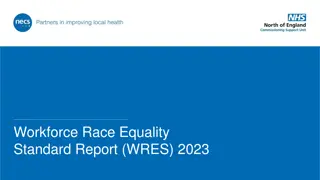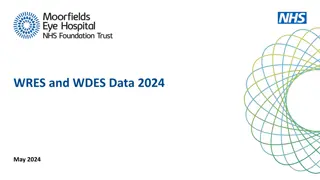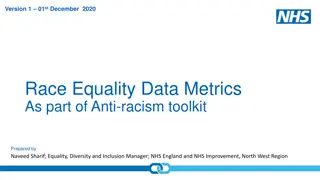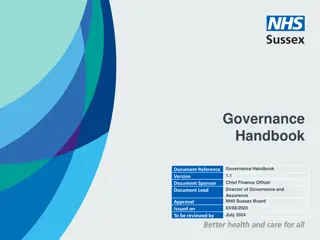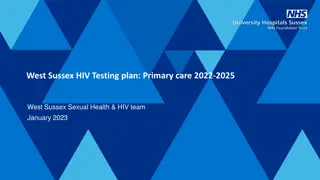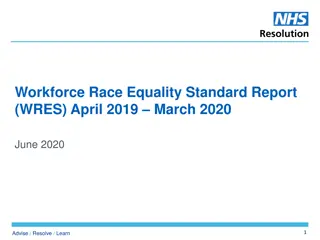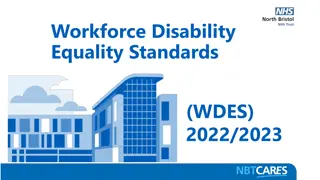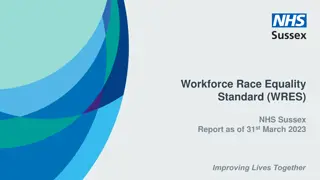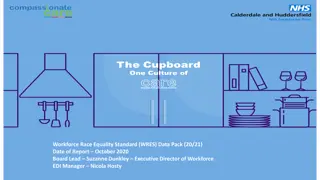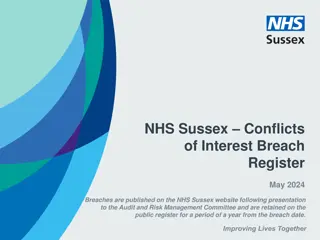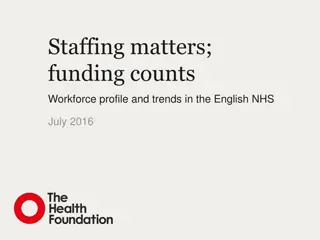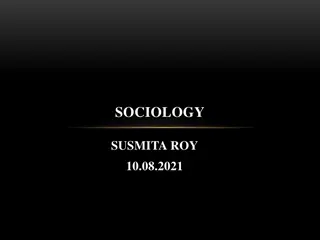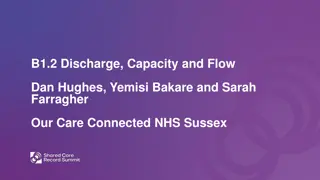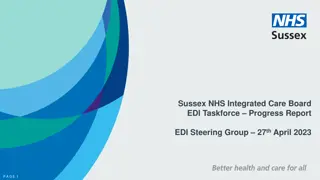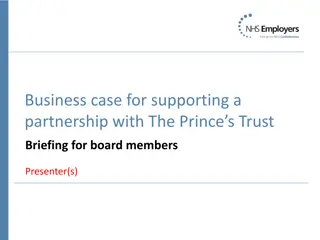Sussex NHS Workforce Race Equality Standard (WRES) Report 2021-22 Highlights
The draft report highlights improvements in workforce diversity and reduced discrimination within Sussex Clinical Commissioning Groups for 2021-22. Ethnically diverse staff have increased, but disparities remain in access to training and career opportunities. Bullying and harassment rates are lower among ethnically diverse staff, but discrimination from managers and colleagues persists. Board diversity has improved, with no ethnically diverse staff in formal disciplinary processes.
Download Presentation

Please find below an Image/Link to download the presentation.
The content on the website is provided AS IS for your information and personal use only. It may not be sold, licensed, or shared on other websites without obtaining consent from the author.If you encounter any issues during the download, it is possible that the publisher has removed the file from their server.
You are allowed to download the files provided on this website for personal or commercial use, subject to the condition that they are used lawfully. All files are the property of their respective owners.
The content on the website is provided AS IS for your information and personal use only. It may not be sold, licensed, or shared on other websites without obtaining consent from the author.
E N D
Presentation Transcript
NHS Sussex Workforce Race Equality Standard (WRES) Report DRAFT 2021-22 Report
Sussex Clinical Commissioning Groups WRES 2021/22 Headlines 88.4% NOT experiencing bullying and harassment from patients 89.7% NOT experiencing bullying and harassment from colleagues 87.5% NOT experiencing discrimination from colleagues 1.67 appointment ratio 90 ethnically diverse staff Our shortlisting to appointment ratio has improved from 2.02 in 2020/21 but still remains slightly above the average of 1.61. We have been joined by 27 new staff from ethnically diverse communities during the last year. A total of 9.6% of our workforce. Fewer ethnically diverse staff experienced bullying and harassment from colleagues than white staff Fewer ethnically diverse staff experienced bullying and harassment from patients and the public than white staff. Ethically diverse staff are more likely to experience discrimination from managers and colleagues than white staff 30.6% Feel they have access to career opportunities 1.21 17.1% Board diversity 0 9.7% Unknown ethnicity Accessing training and development Disciplinary processes Only 30.% of our ethnically diverse staff feel they have equal access to career opportunities compared to 56.2% of white staff. This is a key priority to tackle this year. White staff are 1.21 times more likely to access non mandatory training and development compared to our ethnically diverse staff. No ethnically diverse staff have entered the formal disciplinary process. This figure has stayed the same for several years. The percentage of ethnically diverse Board members has increased in 2021/22, but our new Integrated Care Board established in July 2022 meaning this may have changed. Our percentage of known ethnicity is improving as more staff record their ethnicity on ESR.
Sussex Clinical Commissioning Groups WRES 2021/22 Headlines In summary, the percentage of ethnically diverse staff employed by Sussex NHS Commissioners has increased during 2021/22. Actual staff numbers with recorded ethnicity have increased from 63 to 90 people and from 7.4% to 9.6% respectively. This is an increase of 27 staff and 2.2%. The relative likelihood of white staff accessing non- mandatory training and CPD compared to ethnically diverse staff stands at a ratio of 1.21. This means that ethnically diverse staff were less likely to access development than white staff in the last year and the figure is slightly worse than the national average of 1.14. The number and percentage of staff with unknown ethnicity has decreased slightly and stands at 91 and 9.7% respectively. Ethnically diverse staff (89.7%) reported they had not experienced harassment, bullying or abuse from staff in the last 12 months compared to 85.9% of white staff. However, in relation to experiencing discrimination at work from a manager/team leader and other colleagues, 87.5% of ethnically diverse staff reported that they had not experienced discrimination at work in comparison to 95% of white staff. The likelihood of White staff being appointed from shortlisting compared to ethnically diverse staff has reduced from 2.02 in 2020/21 and now stands at 1.67. This is an improvement but still slightly lower than the national average of 1.61. A significantly higher percentage of white staff (56.2%) reported that they believed that the organisation acts fairly regarding career compared to just 30.6% of ethnically diverse staff. The number of ethnically diverse staff entering the Sussex CCGs formal disciplinary process remains at zero, which is consistent with previous years and compares favourably to the national average of 1.14. During the 12-month period 1 April 2021 to 31 March 2022, the percentage of ethnically diverse voting Board members increased from 13.6% to 17.1%. This is representative of ethnically diverse staff employed overall in the workforce. However, a new Board was created as part of the transition to the Integrated Care Board in July 2022 so this result will need to be reconsidered. A higher percentage of Ethnically diverse staff (88.4%) reported that they had not experienced harassment, bullying or abuse from patients or relatives of the public in the last year compared to white staff (84.9%)
Workforce Diversity Workforce Diversity Analysing workforce data enables us to understand the ethnic diversity of our organisation and consider where positive action may be required. Comparing this to our local ethnically diverse population can also help us understand the extent to which we are representative of our populations. The 2011 census data suggests that 6% of Sussex residents identify as ethnically diverse. This data indicates that our combined NHS Sussex workforce is representative of the ethnically diverse population - however, census data was gathered 11 years ago and we await Census 2021 results so this is likely to be very different. In the past 12 months the percentage of ethnically diverse staff employed by Sussex NHS has increased by 2.2%. The overall number and percentage of ethnically diverse staff employed has increased from 63 to 90 and from 7.4% to 9.6% respectively. This is an increase of 27 staff and 2.2%. The percentage of staff with unknown ethnicity has decreased slightly and stands at 91 and 9.7% respectively. Date Number of White staff staff of Ethnically Diverse Staff 31 March 2019 666 82% % White Number % Ethnically Diverse Staff Number of unknown ethnicity % unknown ethnicity 85 10.5% 61 7.5% 666 82.5% 89 11% 31 March 2020 52 6.4% 707 759 82% 80.7% 96 91 11% 9.7% 31 March 2021 31 March 2022 63 90 7.4% 9.6%
Indicator 1(A): Percentage and headcount of clinical (non- medical) ethnically diverse staff at each pay band compared to white staff (as at 31.03.22) There has been an increase in the overall headcount of clinical (non medical) ethnically diverse staff. White Staff Ethnically Diverse Staff Unknown ethnicity % Headcount % Headcount % Headcount 202 1 2021 2022 2022 2021 2022 2021 2022 2021 2022 2021 2022 Pay Bands under 1 and 1 to 4 Pay Bands 5 to 7 Pay Bands 8a to 8b Pay Bands 8c to 9 to VSM 100% 80% 3 0% 0 0% 0 4 20% 1 0% 0 There has been a decrease in the percentage of unknown ethnicity in all clinical (non medical) pay bands. 86% 85.7% 132 132 6% 9 8% 12 7.1% 11 7.1% 11 11.5 % 80% 79.5% 69 10% 9 9% 8 62 9 9% 7 70% 75% 7 0% 0 30% 3 15 10% 2 15% 3
Indicator 1(B): Percentage and headcount of non-clinical ethnically diverse staff at each pay band compared to white staff (as at 31.03.22) White Staff Ethnically Diverse Staff Unknown ethnicity Sussex CCGs % Headcount % Headcount % Headcount 2021 2022 2021 2022 2021 2022 2021 2022 2021 2022 2021 2022 Pay Bands under 1 and 1 to 4 92% 93 4% 4 4% 4 90% 102 8% 9 2% 2 Pay Bands 5 to 7 82% 184 8% 17 11% 24 81% 213 8% 22 10% 27 Pay Bands 8a to 8b 83% 128 5% 8 12% 19 77% 97 11% 14 12% 15 Pay Bands 8c to 9; VSM 74% 57 12% 9 14% 11 79 % 103 12% 15 9% 12 There has been an increase in the percentage and headcount of ethnically diverse staff and a decrease in unknown ethnicity in every non-clinical pay band. However, there is an under representation of ethnically diverse staff in comparison to the overall ethnically diverse workforce of 9.7% in non clinical pay bands 1 - 4 and 5 to 7.
Indicator 1(C): Percentage and headcount of clinical (medical) ethnically diverse staff at each pay band compared to white staff (as at 31.03.22) White Staff Ethnically diverse Staff Unknown ethnicity % Headcount % Headcount % Headcount 2021 2022 2021 2022 2021 2022 2021 2022 2021 2022 2021 2022 61 % 60% 34 31 12% 13% 7 27% 27% 15 Other 7 14 This slide shows medical staff as a group in their own right however they are also reflected in the other workforce slides. There has been a one percentage point increase in ethnically diverse staff employed in clinical (medical) roles, however this is due to a reduction in the overall headcount. There has been no overall change to the headcount of ethnically diverse staff employed. There is likely to be a correlation between staff with unknown ethnicity and the percentage decreases.
Indicator 2: Relative likelihood of White applicants being appointed from shortlisting across all posts compared to ethnically diverse applicants Our March 2022 data suggests that the relative likelihood of White staff being appointed from shortlisting compared to ethnically diverse staff has reduced and now stands at 1.67 (i.e. White members of staff are more than one and a half times as likely to be appointed from shortlisting). Organisation 2020 2021 2022 Sussex NHS ICB 2.28 2.02 1.67 This is an improvement however we recognise that this is slightly worse than the 1.61 national average and 1.48 average for NHS Trusts in the South East so further improvement remains a high priority.
Indicators Three and Four Indicator 3: Relative likelihood of ethnically diverse staff entering the formal disciplinary process compared to White staff (as measured by entry into a formal disciplinary investigation) The number of ethnically diverse staff entering the NHS Sussex formal disciplinary process remains at zero, which is consistent with previous years and compares favourably to the national average of 1.14. Indicator 4: Relative likelihood of ethnically diverse staff accessing non- mandatory training and continuous professional development (CPD) compared to White staff In 2019 and 2020 administrative restrictions meant that NHS Sussex was unable to provide data for this indicator and we were only able to report on this in 2021. Our March 2022 data suggests that the relative likelihood of white staff accessing non-mandatory training and CPD compared to ethnically diverse staff stands at a ratio of 1.21 This means that ethnically diverse staff were less likely to access development than white staff in the last year. This is slightly worse than the national average of 1.14.
Data relating to Indicators 5 to 8 is sourced from the annual NHS Staff Survey. CCGs have not historically been required to undertake the staff survey. Sussex NHS Commissioners (as was) however undertook the survey in 2021 and prior to that staff participated in local temperature check surveys. Indicator 5: Percentage of staff experiencing harassment, bullying or abuse from patients, relatives or the public in last 12 months A higher percentage of ethnically diverse staff 88.4% reported that they had not experienced harassment bullying or abuse from patients relatives of the public in the last year in comparison to 84.9% white staff. This is a favourable result for our ethnically diverse staff. Indicators 5-8 Indicator 6: Percentage of staff experiencing harassment, bullying or abuse from staff in last 12 months A higher percentage of ethnically diverse staff 89.7% reported that they had not experienced harassment, bullying or abuse from staff in the last 12 months in comparison to 85.9% of white staff. This is a favourable result for our ethnically diverse staff. Indicator 7: Percentage of staff believing that trust provides equal opportunities for career progression or promotion A significantly higher percentage of white staff (56.2%) reported that they believed that the organisation acts fairly in regards to career progression in comparison to 30.6 % of ethnically diverse staff. This is an adverse outcome for ethnically diverse staff and a priority for focus in 2022. Indicator 8: Percentage of staff personally experiencing discrimination at work from a manager/team leader or other colleagues A lower percentage of ethnically diverse staff 87.5% reported that they had not experienced discrimination at work from a manager/team leader and other colleagues in comparison to 95% of white staff. This is an adverse outcome for ethnically diverse staff and a priority focus in 2022.
Indicator 9: Percentage difference between the organisation s Board voting membership and its overall workforce NHS Sussex became an Integrated Care Board in July 2022 and a new Board was formed. This data relates to the previous CCG Governing Body and will therefore be refreshed for 2022. Sussex CCG Governing Body Profile % Ethnically diverse 9.3% 13.6% 17.11% Year % White % Unknown 62.8% 63.6% 63.4% 27.9% 22.7% 19.5% 2020 2021 2022 During the 12-month period 1 April 2021 to 31 March 2022, the percentage of voting ethnically diverse Board members (i.e. voting Governing Body members) increased from 13.6% to 17.1%. This positive movement was achieved by the application of targeted action to improve Board-level representation. This is representative in comparison to the percentage ethnically diverse staff employed overall n the workforce. However, there remained a high level of unknown ethnicity amongst Board members.
WRES Improvement and Delivery Plan 2022/23 Appendix One of this report is an Excel programme plan which outlines our improvement actions for 2022/23. We will continue to focus on improvement on across all areas of the WRES and work towards being an exemplar employer in relation to ethnic diversity in the workforce. The key areas of focus and action are however highlighted in the Table below. Indicator Key Actions No Increase the percentage and number of ethnically diverse staff across all pay bands and staff groups Directorate diversity targets ESR diversity data promotion 1 Reduce the relative likelihood of white applicants being appointed from shortlisting across all posts compared to ethnically diverse applicants Inclusive recruitment programme Diversity champions 2 Relative likelihood of ethnically diverse staff accessing non-mandatory training and continuous professional development (CPD) compared to White staff APSIRE Cohort 2 and 3 4 Percentage of ethnically diverse staff believing that trust provides equal opportunities for career progression or promotion Positive action mentoring programme Co-production workshops 7 Percentage of ethnically diverse staff personally experiencing discrimination at work from a manager/team leader or other colleagues Cultural competency training Staff Network confidential drop ins 8 Analysis of ESR data for new Board and action on any findings Percentage difference between the organisation s Board voting membership and its overall workforce 9





